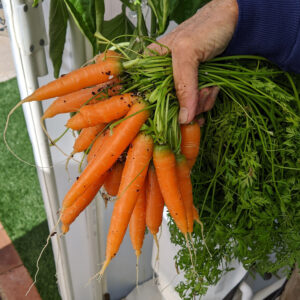
We’ve been experimenting with hydroponic style growing in one of our greenhouses. We are excited to be able to share some details about our set-up and some important lessons learned.
DUTCH BUCKET SYSTEM
In our Diamond Dome greenhouse, we are utilizing a Dutch Bucket System. What we like about this system is that the growing containers don’t take up much space, but they are able to accommodate large fruiting plants - things like tomatoes, cucumbers, and peppers.

The Dutch Bucket System is set up with a series of growing containers that each hold an absorbent growing medium and each have an irrigation emitter from a nutrient tank. Each growing container drains into a shared drain line back to the nutrient tank. This prevents both water and nutrient loss to the floor of the greenhouse.
The medium we use in our buckets is 50/50 coco coir and perlite.
GREENHOUSE LAYOUT
Even with climate control systems in place, different areas of the greenhouse end up being warmer or cooler depending on the sun exposure of the greenhouse. So we've set up our growing zones based on temperature.
Our Zones
Zone A – Center (moderate temperature and takes most advantage of the greenhouse height)
- Tomatoes
Zone B - South/West (tends to be the warmest, especially in the summer)
- Beans
- Cucumbers
- Bell peppers
- Eggplant
- Zucchini
Zone C - east (tends to be cooler in the summer)
- Peas
- Carrots
- Basil
- Swiss chard
- Spinach
- Radishes
Zone D - north (coolest)
- Lettuce
Zoning Alternative
Another way to zone your greenhouse is based on plant nutrient needs. Different crops require different levels of the three major nutrients; nitrogen, phosphorus, and potassium. You can set up different nutrient zones; each growing container in a particular zone would share a nutrient tank that is fine tuned to the nutrient requirements of the plants being grown in that zone.
AIR TEMPERATURE VS WATER TEMPERATURE
Even though we have a thermostat-regulated space heater in the greenhouse, we found that plant growth and production was sluggish in the winter. We keep the winter air temperature at about 45 degrees, and we noticed that the temperature of the nutrient tanks were often reading in the 50's. However, optimal root zone temperature is in the range of 65-80 degrees. Rather than increasing the temperature of the space heaters, we decided to add heaters to the nutrient tanks, keeping the nutrient solution at about 70 degrees. Within a week we noticed a dramatic improvement in plant vigor.
AMOUNT OF PRODUCE
Here are some metrics from the last year:





